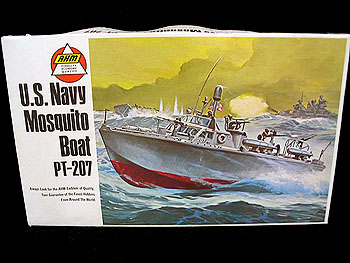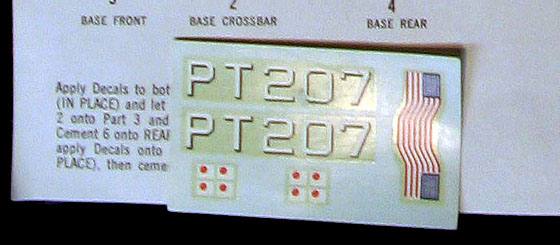|
Editor’s note: The kit pictured for this Revell kit is actually an AHM release of the Revell kit. Everything about the AHM kit came from the Revell kit. Actually, from looking at the box-art, it appears to be the mid-1960s era Revell re-release of the kit in its PT-207 guise.

Back in the 1950s, Revell released a ‘box scale’ (1:104, 1:100 or now 1:96 scale) kit of PT-212. This kit was of a Higgins seventy-eight foot PT-71 Class PT boat. The hull number indicated that it was of Higgins’ second production series of the class, but the model actual depicted a Higgins boat that was put in service at mid-point to late in the war.
The decal sheet, in all of this kit incarnations, included four ‘kill markings’ of four small Japanese flags.

Whereas this is a nice touch, it is not at all historically accurate. This is because none of the boats that this kit was meant to depict ever saw action against the Japanese. In fact, PT-207, PT-211 and PT-212 were all units of PT Squadron 15, which was deployed to the Mediterranean Theater of Operations. After service with the US Navy, these boats were handed over to the British ‘in theater’ and eventually were turned over to the Polish Navy. These boats, in the hands of the Polish Navy, were the prototype of a series of these boats built by the Poles.
The plastic for this kit was molded in gray. Not only were the decals highly inaccurate, but the kit was too. Not only did it not represent the boats which its decals indicated it was, but everything else about the kit was just terrible. But, then again, one has to remember what era in which it was created. The deck was filled with errors. In the photo of the deck and the hull, one can see that, as with models from that era, a lot of the details were molded into the model. This refers to things such as the life-raft, the anchor and the ammunition ready-service lockers and the anti-skid panels around the two after gun positions. Those panels on the kit are raised, making them appear to be raised platforms.
Another ‘error’ in this kit is that there is a box-like structure which is located behind the cockpit area. Real Higgins PT boats did not have these structures. What this structure actually is, if one looks at an overhead view of a line drawing or a blue-print of a Higgins PT boat, one will see the outline of the access panel for either the engine-room (to change the engines during over-hauls) or access to the fuel tanks. Revell must have seen this outline and assumed, without consulting the side-view, that there was a box-like structure there. The different ammunition ready service lockers are no more than just square-shaped structures on the deck. The two 20mm Oerlikons look nothing like the real things and they have the gunner figures attached to them and the object that represents the 40mm gun does not even look like the real Bofors gun. The twin .50s are just box-like structures with sticks on them. Granted, this kit goes back to the 1950s, which was an era in which models were regarded as toys, but still. Unfortunately for the ‘modern era’ modeler, no one makes after-market accessories for this (or any kit for that matter) kit in either 1:100 1:104 scale (‘box-scales’).
But since Revell has recently re-released this kit again and stating that its scale is 1:96, there are a few companies out there which do provide after-market accessories in that scale. Most notably, John R. Haynes of England makes excellent examples of both the 40mm Mk. III gun and both Marks of the 20mm gun (either the Mark IV and the Mark X) that would help greatly to detail this kit.
Conclusion
Well, there you have it, a run down of the Revell plastic injection-mold type kits of US PT Boats. I hope it helps you and I would like to thank both Mr. Johnson and Mr. Traxel for their valued input in the preparation of this article.
|